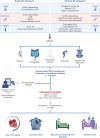Gaps and Knowledge in the Contemporary Management of Acute Right Ventricular Failure
- PMID: 40223610
- PMCID: PMC12435249
- DOI: 10.1161/CIRCHEARTFAILURE.124.012030
Gaps and Knowledge in the Contemporary Management of Acute Right Ventricular Failure
Abstract
Acute right ventricular failure (ARVF) is commonly seen in the intensive care unit and constitutes a significant clinical challenge, with associated high in-hospital mortality. Recently, the treatment of ARVF has significantly changed, with the progressive implementation of mechanical circulatory support devices that now represent important tools for clinicians in treating this condition. However, despite recent advancements, the optimal approach for ARVF remains elusive, and precise treatment algorithms and comprehensive management protocols are still lacking. In the present review, we explore the pathophysiology of ARVF, highlighting the different mechanisms that may lead to this clinical entity and emphasizing the left and right heart's complex interplay. We analyze the different therapeutic options that are now available for short- and long-term management of ARVF, with a particular focus on the advantages and disadvantages of the mechanical circulatory support devices actually used. Furthermore, we propose future directions in the field and a possible flowchart for the treatment of this condition.
Keywords: heart; heart failure; hospital mortality; intensive care units; software design.
Conflict of interest statement
None.
Figures




References
-
- Harjola VP, Mebazaa A, Čelutkiene J, Bettex D, Bueno H, Chioncel O, Crespo-Leiro MG, Falk V, Filippatos G, Gibbs S, et al. Contemporary management of acute right ventricular failure: a statement from the Heart Failure Association and the Working Group on Pulmonary Circulation and Right Ventricular Function of the European Society of Cardiology. Eur J Heart Fail. 2016;18:226–241. doi: 10.1002/ejhf.478 - PubMed
-
- Konstam MA, Kiernan MS, Bernstein D, Bozkurt B, Jacob M, Kapur NK, Kociol RD, Lewis EF, Mehra MR, Pagani FD, et al. ; American Heart Association Council on Clinical Cardiology; Council on Cardiovascular Disease in the Young; and Council on Cardiovascular Surgery and Anesthesia. Evaluation and management of right-sided heart failure: a scientific statement from the American Heart Association. Circulation. 2018;137:e578–e622. doi: 10.1161/CIR.0000000000000560 - PubMed
Publication types
MeSH terms
LinkOut - more resources
Full Text Sources
Medical

